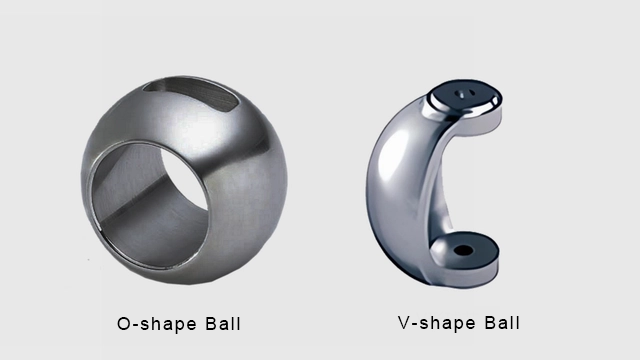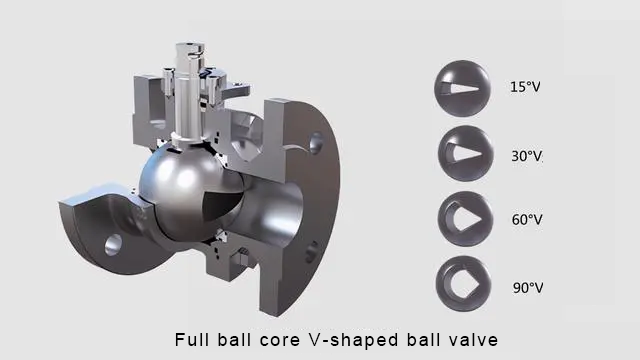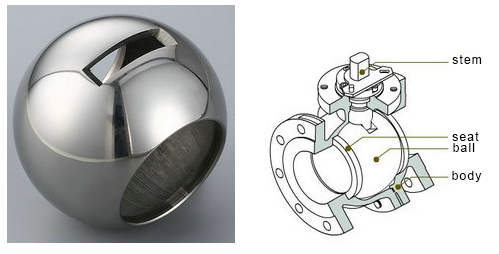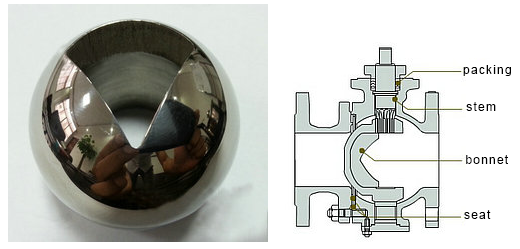
Ball valves have many structures, but they are basically the same. The opening and closing parts are round spherical cores, which are mainly composed of valve seats, balls, sealing rings, valve stems and other Operating devices. The valve stem rotates 90 degrees to achieve the opening and closing of valves. The ball valves are used on pipelines to shut off, distribute, regulate flow and change the flow direction of medium. The valve seat uses different seat sealing forms according to different working conditions. The body of the O-type ball valve is equipped with a ball with a middle through hole whose diameter equal to the diameter of the pipe. The ball can rotate in the sealing seat. There is an annular elastic ring on both sides in the direction of the pipe. The V-type ball valve has a V-shaped structure. The valve core is a 1/4 spherical shell with a V-shaped notch. It has large flow capacity, a large adjustable range, shearing force, and can be tightly closed. It is especially suitable for fluids conditions where the material is with fibrous.
1. O-type ball valve structure:
The O-type ball valve control the direction of medium by y rotating the ball 90°, as a result, the through hole can be changed, thereby realizing the opening and closing of the ball valve. The O-type ball valve adopts floating or fixed design. The relative moving parts are made of self-lubricating materials with extremely small friction coefficient, so the operating torque is small. In addition, the long-term sealing of sealing grease makes the operation more flexible. Its product advantages are as follows:
-
O-type ball valve has small fluid resistance
Ball valves generally have two structures: full diameter and reduced diameter. No matter which structure, the flow resistance coefficient of the ball valve is relatively small. Conventional ball valves are straight-through, also known as full-flow ball valves. The channel diameter is equal to the inner diameter of the pipe, and the resistance loss is only the friction resistance of the same length of pipe. This ball valve has the least fluid resistance of all valves. There are two ways to reduce the resistance of the piping system: one is to reduce the fluid flow rate by increasing the pipe diameter and valve diameter, which will greatly increase the cost of the piping system. The second is to reduce the local resistance of the valve, and ball valves are the best choice.
-
The O-type ball valve switches quickly and conveniently
The ball valve only needs to rotate 90 degrees to fully open or fully close, so it can be opened and closed quickly.
- O-type ball valve has good sealing performance
Most of ball valve seats are made of elastic materials such as PTFE, which are often called soft-sealing ball valves. Soft sealing ball valves have good sealing performance and do not require high roughness and processing accuracy of the valve sealing surface.
-
O-type ball valve has long service life
Because PTFE/F4 has good self-lubricating properties, the friction coefficient with the sphere is small. Due to the improved processing technology, the roughness of the ball is reduced, thereby greatly increasing the service life of the ball valve.
-
O-type ball valve has high reliability
The sealing pair of the ball and the valve seat will not suffer from scratches, rapid wear and other faults;
After the valve stem is changed to the built-in type, the accident risk that the valve stem may fly out due to the loosening of the packing gland under the action of fluid pressure eliminated;
Ball valves with anti-static and fire-resistant structures can be used in pipelines transporting oil, natural gas, and coal gas.
The valve core (ball) of the O-type ball valve is spherical. From a structural point of view, the ball seat is embedded in the seat on the side of the valve body when sealing. The relative moving parts are made of self-lubricating materials with extremely small friction coefficient, so the operating torque is small. In addition, the long-term sealing of sealing grease makes the operation more flexible. Generally used for two-position adjustment, the flow characteristics are quick opening.
When the O-type ball valve is fully open, both sides are unobstructed, forming a straight channel with two-way sealing. It has the best "self-cleaning" performance and is suitable for two-position cutting occasions of particularly unclean and fiber-containing media. The ball core always creates friction with the valve during the opening and closing process of the valve. At the same time, the seal between the valve core and the valve seat is achieved by the pre-tightening sealing force of the valve seat pressing against the ball core. However, due to the soft sealing valve seat, Excellent mechanical and physical properties make its sealing performance particularly good.
2. V-shaped ball valve structure:
The ball core of the V-shaped ball valve has a V-shaped structure. The valve core is a 1/4 spherical shell with a V-shaped notch. It has large flow capacity, a large adjustable range, shearing force, and can be tightly closed. It is especially suitable for fluids. Conditions where the material is fibrous. Generally, V-shaped ball valves are single-seal ball valves. Not suitable for two-way use.
There are mainly 4 type of V-shaped notch, 15 degree, 30 degree, 60 degree, 90 degree.
V-shaped edge cuts off impurities. During the rotation of the ball, the V-shaped sharp knife edge of the ball is tangent to the valve seat, thereby cutting off the fibers and solid substances in the fluid. However, ordinary ball valves do not have this function, so it is easy to cause fiber impurities to get stuck when closing, causing maintenance and repair problems. Maintenance is a huge inconvenience. The valve core of the V-shaped ball valve will not be stuck by fibers. In addition, due to the flange connection, it is easy to disassemble and assemble without special tools, and maintenance is also simple. when the valve is closed. There is a wedge-shaped scissor effect between the V-shaped notch and the valve seat, which not only has a self-cleaning function but also prevents the ball core from getting stuck. The valve body, valve cover and valve seat adopt metal point-to-point structures respectively, and a small friction coefficient is used. The valve stem is spring-loaded, so the operating torque is small and very stable.
The V-shaped ball valve is a right-angle rotary structure that can achieve flow regulation. It can achieve different degrees of proportion according to the V-shaped angle of the V-shaped ball. The V-shaped ball valve is generally used in conjunction with valve actuators and positioners to achieve proportional adjustment. , V-shaped valve core is most suitable for various adjustment occasions. It has a large rated flow coefficient, a large adjustable ratio, a good sealing effect, zero sensitivity in adjustment performance, a small size, and can be installed vertically or horizontally. Suitable for controlling gas, steam, liquid and other media. The V-shaped ball valve is a right-angle rotary structure, which is composed of a V-shaped valve body, a pneumatic actuator, a positioner and other accessories; it has an inherent flow characteristic of approximately equal ratio; it adopts a double-bearing structure, has small starting torque, and has excellent Sensitivity and sensing speed, super shearing ability.


